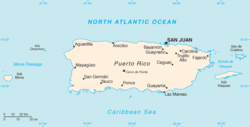
The following outline is provided as an overview of and topical guide to Puerto Rico:
Contents
- General reference
- Geography of Puerto Rico
- Environment of Puerto Rico
- Regions of Puerto Rico
- Demography of Puerto Rico
- Government and politics of Puerto Rico
- Branches of the government of Puerto Rico
- Foreign relations of Puerto Rico
- Law and order in Puerto Rico
- Military of Puerto Rico
- Local government in Puerto Rico
- History of Puerto Rico
- Culture of Puerto Rico
- Art in Puerto Rico
- Cuisine
- Sports in Puerto Rico
- Economy and infrastructure of Puerto Rico
- Education in Puerto Rico
- Infrastructure of Puerto Rico
- See also
- References
- External links
The Commonwealth of Puerto Rico is a self-governing unincorporated territory of the United States of America located in the northeastern Caribbean, east of the Dominican Republic and west of the Virgin Islands. [1] The commonwealth comprises an archipelago that includes the main island of Puerto Rico and a number of smaller islands and keys, the largest of which are Vieques, Culebra, and Mona. The main island of Puerto Rico is the least extensive but the third most populous of the four Greater Antilles: Cuba, Hispaniola, Jamaica, and Puerto Rico.
Puerto Ricans often call the island Borinquen, from Borikén, its indigenous Taíno name. [2] [3] The terms boricua and borincano derive from Borikén and Borinquen respectively, and are commonly used to identify someone of Puerto Rican heritage. The island is also popularly known as "La Isla del Encanto", which translated means "The Island of Enchantment."




